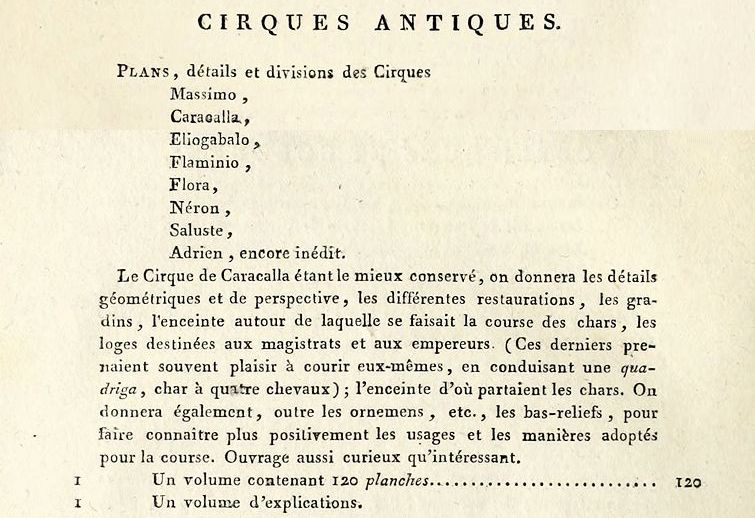
Exerpt from Francesco Piranesi, Calcographie des Piranesi, ou, Traite“ des arts d'architecture, peinture et sculpture : de“veloppe“s par la vue des principaux monumens antiques et modernes, Paris, 1804.
| |
Stephen Lauf
1. The second part of Calcographie des Piranesi, ou, Traite“ des arts d'architecture, peinture et sculpture : de“veloppe“s par la vue des principaux monumens antiques et modernes comprises the descriptions of three large proposed works: Antiquities of Magna Graecia, now Kingdom of Naples; 21 vol., Antiquities of Rome, built from the time of Kings, Republics and Emperors, down to Constantine; 35 vol., Antiquities of Preneste; 21 vol. Ancient Circuses was intended as two of the 35 volumes of Antiquities of Rome. The author first became aware of the Ancient Circuses text 6 June 2022.
2. The Circus of Caracalla was correctly identified as the Circus of Maxentius by Antonio Nibby circa 1825.
3. The author discovered two states of 'Pianta degli avanzi di un 'antica Villa, sue Fabbriche, e Circo volgarmente detto di Caracalla fuori di porta S. Sebastiano' online 29 May 2022. A first state printing of the site plan exists within the Universitätsbibliothek Heidelberg copy of Le Antichitą Romane vol. 1. A second state printing of the site plan exists within the Getty Research Institute copy of Le Antichitą Romane vol. 1.
|
| |
The Discovery of Piranesi's Final Project
Curious and interesting work.
--Giovanni Battista Piranesi, Calcographie des Piranesi
|
As it turns out, Giovanni Battista Piranesi already wrote a description, and a review, of his final project. The short text appears within the Calcographie des Piranesi, a catalogue listing the existing and projected works by Giovanni Battista and Francesco Piranesi, des Piranesi, published by Francesco in Paris, 1804, almost sixteen years after his father's, Giovanni Battista's death, and less than six years before his own death.
ANCIENT CIRCUSES.1
Plans, details and division of the Circuses
Maximus,
Caracalla,
Eliogabalo,
Flaminius,
Flora,
Nero,
Salust,
Hadrian, still unpublished.
The Circus of Caracalla2 being the best preserved, we will give the geometric and perspective details, the various restorations, the bleachers, the enclosure around which the chariot race took place, the boxes intended for the magistrates and the emperors. (The latter often took pleasure in racing themselves, driving a quadriga, four-horse chariot); the enclosure from which the chariots left. Besides the ornaments, etc., the bas-reliefs will also be mentioned, in order to make known more positively the uses and the manners adopted for the race. Curious and interesting work.
One volume containing 120 plates
One volume of explanations.
Only three etchings related to the so-called Circus of Caracalla exist within the Piranesis' oeuvre: a detailed plan of the circus with notes and dimensions by Francesco from circa 1786 labeled 'Icnografia del Circo de Caracalla fuori della Porta Capena in oggi S. Sebastiano,' and an unsigned and undated site plan labeled 'Pianta degli avanzi di un 'antica Villa, sue Fabbriche, e Circo volgarmente detto di Caracalla fuori di porta S. Sebastiano,' existing in two printed states3. Francesco published all three etchings almost a decade after Piranesi's death
|
|
